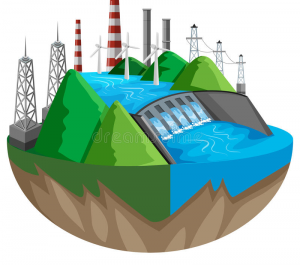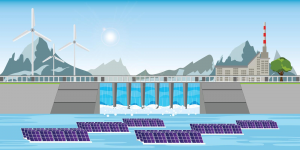Introduction
The goal of this project is to integrate a system that contains the following systems: floating solar photovoltaic park, dam, off-shore wind turbine and a substation. The basis for these systems is the individual research projects conducted in ontology models and parametric design. In order to understand the interactions and functions of the integrated system, group members communicated the most essential parts of their systems transparently and very effectively though the ontology models and connection points could be easily identified. This also helped us to understand products that were modelled at different scale, at the parametric design is a flexible tool to help us formulate an integrated design solution.
Storyline
After reading and comparing the induvial ontology models, a very realistic and pragmatic integration context was able to be written. The integration revolves around a dam connected to a substation. This is very common practice, but what makes this narrative interesting is that in the reservoir off-shore wind turbines are stationed and provide energy directly to the substation. Conventionally, off-shore wind turbines are meant in somewhat deeper water 30-40 meters, and the dam also works to keep the reservoir at this level. Up stream, a farm of floating solar photovoltaic panels are stationed that are also connected to the same substation. The panels are on floating barges and anchored with mooring lines that are only designed for a depth of 15-25 meters. In this case, the dam also ensure that the water level for the mooring line and anchoring system stays in the high performance range.
Figure 1: Photo (Source: dreamstime.com)
Figure 2: Photo (Source: dreamstime.com)
Engineering Challenge
The interactions between the systems identify the following problems:
(1) Power is carried from the floating solar photovoltaic and off-shore wind turbine to subsystem via two transmission lines. Subsystems are designed to provide sufficient energy, meet power demand for substation and avoid dangerous surpluses. This is based of the sizing and design for the floating solar photovoltaic park and off-shore wind turbines explored in parametric modelling.
(2) Dam ensures that the water level for the floating solar photovoltaic farm stays in designated 15-20 meter range
(3) Dam holds water upstream in 30-40 meter range as designated for the off-shore wind turbine
From a engineers perspective, the energy loads for two different sources of renewable energy connected to a sub-station is the biggest concerns. Because if the demand is not met, a nearby city can experience power outages, or there can be dangerous surpluses or different problems such as power lags or blown transformers in the substation.
A big issue is that the four sub-systems were first scaled individually, so the parametric modelling is a useful tool needed to scale and design the two energy sources for the substation, and after some information about the load, the substation can subsequently be designed to safely handle the power that will be produced by the system.

